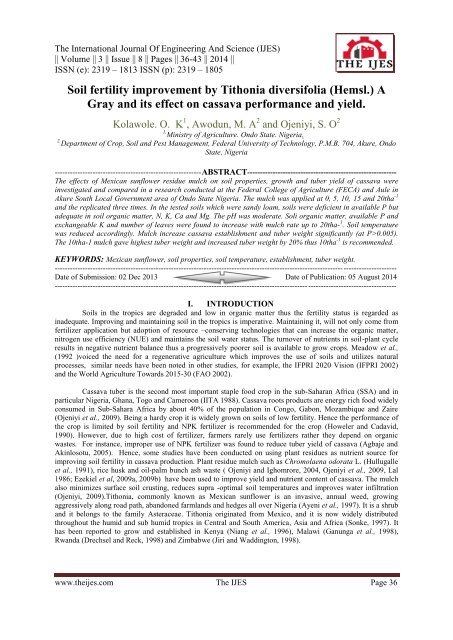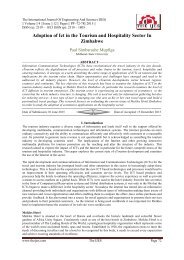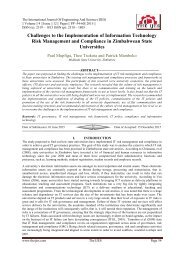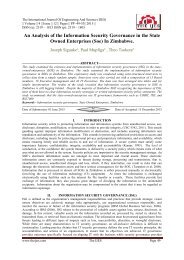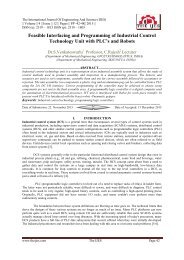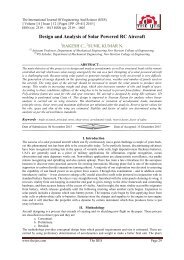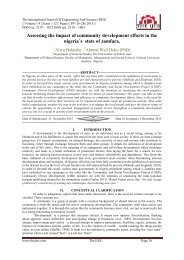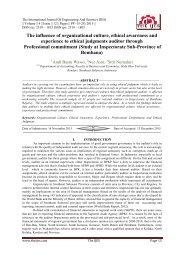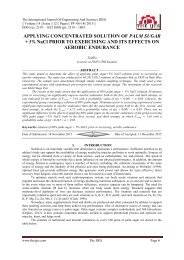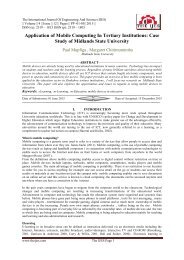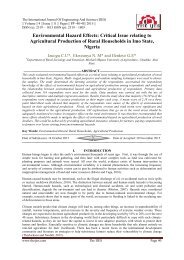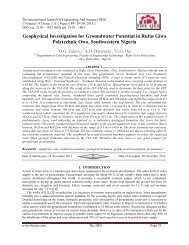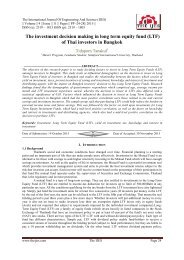You also want an ePaper? Increase the reach of your titles
YUMPU automatically turns print PDFs into web optimized ePapers that Google loves.
The International Journal Of Engineering And Science (IJES)<br />
|| Volume || 3 || Issue || 8 || Pages || 36-43 || 2014 ||<br />
ISSN (e): 2319 – 1813 ISSN (p): 2319 – 1805<br />
Soil fertility improvement by Tithonia diversifolia (Hemsl.) A<br />
Gray and its effect on cassava performance and yield.<br />
Kolawole. O. K 1 , Awodun, M. A 2 and Ojeniyi, S. O 2<br />
1, Ministry of Agriculture. Ondo State. Nigeria.<br />
2, Department of Crop, Soil and Pest Management, Federal University of Technology, P.M.B. 704, Akure, Ondo<br />
State, Nigeria<br />
----------------------------------------------------------ABSTRACT-----------------------------------------------------------<br />
The effects of Mexican sunflower residue mulch on soil properties, growth and tuber yield of cassava were<br />
investigated and compared in a research conducted at the Federal College of Agriculture (FECA) and Aule in<br />
Akure South Local Government area of Ondo State Nigeria. The mulch was applied at 0, 5, 10, 15 and 20tha -1<br />
and the replicated three times. In the tested soils which were sandy loam, soils were deficient in available P but<br />
adequate in soil organic matter, N, K, Ca and Mg. The pH was moderate. Soli organic matter, available P and<br />
exchangeable K and number of leaves were found to increase with mulch rate up to 20tha- 1 . Soil temperature<br />
was reduced accordingly. Mulch increase cassava establishment and tuber weight significantly (at P>0.005).<br />
The 10tha-1 mulch gave highest tuber weight and increased tuber weight by 20% thus 10tha -1 is recommended.<br />
KEYWORDS: Mexican sunflower, soil properties, soil temperature, establishment, tuber weight.<br />
---------------------------------------------------------------------------------------------------------------------------------------<br />
Date of Submission: 02 Dec 2013 Date of Publication: 05 August 2014<br />
---------------------------------------------------------------------------------------------------------------------------------------<br />
I. INTRODUCTION<br />
Soils in the tropics are degraded and low in organic matter thus the fertility status is regarded as<br />
inadequate. Improving and maintaining soil in the tropics is imperative. Maintaining it, will not only come from<br />
fertilizer application but adoption of resource –conserving technologies that can increase the organic matter,<br />
nitrogen use efficiency (NUE) and maintains the soil water status. The turnover of nutrients in soil-plant cycle<br />
results in negative nutrient balance thus a progressively poorer soil is available to grow crops. Meadow et al.,<br />
(1992 )voiced the need for a regenerative agriculture which improves the use of soils and utilizes natural<br />
processes, similar needs have been noted in other studies, for example, the IFPRI 2020 Vision (IFPRI 2002)<br />
and the World Agriculture Towards 2015-30 (FAO 2002).<br />
Cassava tuber is the second most important staple food crop in the sub-Saharan Africa (SSA) and in<br />
particular Nigeria, Ghana, Togo and Cameroon (IITA 1988). Cassava roots products are energy rich food widely<br />
consumed in Sub-Sahara Africa by about 40% of the population in Congo, Gabon, Mozambique and Zaire<br />
(Ojeniyi et al., 2009). Being a hardy crop it is widely grown on soils of low fertility. Hence the performance of<br />
the crop is limited by soil fertility and NPK fertilizer is recommended for the crop (Howeler and Cadavid,<br />
1990). However, due to high cost of fertilizer, farmers rarely use fertilizers rather they depend on organic<br />
wastes. For instance, improper use of NPK fertilizer was found to reduce tuber yield of cassava (Agbaje and<br />
Akinlosotu, 2005). Hence, some studies have been conducted on using plant residues as nutrient source for<br />
improving soil fertility in cassava production. Plant residue mulch such as Chromolaena odorata L. (Hullugalle<br />
et al., 1991), rice husk and oil-palm bunch ash waste ( Ojeniyi and Ighomrore, 2004, Ojeniyi et al., 2009, Lal<br />
1986; Ezekiel et al, 2009a, 2009b) have been used to improve yield and nutrient content of cassava. The mulch<br />
also minimizes surface soil crusting, reduces supra -optimal soil temperatures and improves water infiltration<br />
(Ojeniyi, 2009).Tithonia, commonly known as Mexican sunflower is an invasive, annual weed, growing<br />
aggressively along road path, abandoned farmlands and hedges all over Nigeria (Ayeni et al., 1997). It is a shrub<br />
and it belongs to the family Asteraceae. Tithonia originated from Mexico, and it is now widely distributed<br />
throughout the humid and sub humid tropics in Central and South America, Asia and Africa (Sonke, 1997). It<br />
has been reported to grow and established in Kenya (Niang et al., 1996), Malawi (Ganunga et al., 1998),<br />
Rwanda (Drechsel and Reck, 1998) and Zimbabwe (Jiri and Waddington, 1998).<br />
www.theijes.com The IJES Page 36
Soil fertility improvement by Tithonia diversifolia (Hemsl.)…<br />
The reported uses of tithonia includes fodder (Anette, 1996; Roothaert and Patterson, 1997; Roothaert<br />
et al., 1997), poultry feed (Odunsi et al., 1996), animal feed (Farinu et al., 1999; Olayemi, 2006) fuel wood<br />
(Ng’inja et al., 1998), compost (Drechsel and Reck, 1998; Ng’inja et al., 1998), land demarcation (Ng’inja et<br />
al., 1998), soil erosion control (Ng’inja et al., 1998), building materials and shelter for poultry (Otuma et al.,<br />
1998). In addition, extracts from tithonia plant parts reportedly protect crops from termites (Adoyo et al., 1997)<br />
and contain chemicals that inhibit plant growth (Baruah et al., 1994; Tongma et al., 1997) control insects<br />
(Carino and Rejestes, 1982; Dutta et al., 1993 Akanbi et al., 2007) and nematicide (Jama et al., 2000). Extracts<br />
of tithonia also have medicinal value for treatment of hepatitis (Lin et al., 1993; Kuo and Chen, 1997) and<br />
control of amoebic dysentery (Tona et al., 1998).<br />
In the works of Buresh and Niang, 1997 and Jama et al., 2000 enumerate the potentials of Mexican<br />
sunflower (Tithonia diversifolia; Fam) in supplying and maintaining soil nutrients after periods of<br />
decomposition. It has been used as an organic fertilizer for vegetable crops, its use as green manure resulted in<br />
an increase in maize (Zea mays) yield and it proved as an effective source of nutrients for lowland rice (Oryza<br />
sativa) (Jama et al., 2000, Nagarajah and Nizar; 1982 Nziguheba et al., 2002; Sangakkara et al., 2002). It was<br />
found as effective nutrient source for maize, beans and vegetables in Kenya, |Malawi and Zimbabwe (Jama et<br />
al., 2000) and yam in Nigeria( Adeniyan et al., 2008). Atayese and Liasu (2001) found that soil under tithonia<br />
and siam weed had higher pH, porosity, moisture content, N, P, K Na Ca, mycohorizal fungi spores and<br />
earthworm casts density and lower bulk density compared with bare soil. Similar observations were made by<br />
Ojeniyi et al., (2012). In Nigeria, the potential of tithonia as source of nutrients and for increasing crop yield<br />
has not received adequate study compared with other plant residues. The aim of this work is to study effect of<br />
tithonia residue mulch on soil physic- chemical properties, growth and yield of cassava.<br />
II. MATERIALS AND METHODS.<br />
Field Experiments.<br />
Experiments were carried out at Federal College of Agriculture Akure (FECA), Ado- Owo road Akure<br />
and Aule Village, both in Akure , Ondo State. The geographical location of both sites lies between, Latitude 7 0<br />
5 1 N, Longitude 4 0 55 1 and Latitude 7 0 5 1 and Longitude 5 0 53 1 respectively, in the rainforest zone of Southwest<br />
Nigeria. The soil at both sites were classified as fine kaolinitic, isohyperthermic, Oxic Paleustaff or Ferric<br />
Luvisol ( Adekiya and Ojeniyi 2002). The sites were cropped to maize and cassava for 6 and 5 years<br />
respectively before clearing and the land was manually cleared. The rainfall is between 1100 to 1500mm per<br />
annum and the average temperature is 24.0 o C.<br />
Planting materials. : Cassava cuttings were obtained from the Federal College of Agriculture Research Farm.<br />
The cuttings were obtained from eight month species of Manihot spp. Five levels of tithonia residues were<br />
applied as mulch to cassava cuttings planted on heaps at 1x1m to give 1000 plants /ha. The mulch treatments<br />
were 0, 5, 10, 15, and 20t/ha replicated three times given fifteen treatments plots per site. Each plot was 25m 2.<br />
Treatments were apportioned using a randomized complete block design.<br />
Planting and harvesting operations: Planting of cassava sticks were done in April 2009 at each site and<br />
mulching were applied on heaps according to treatments - 28days later. Harvesting was done 36weeks after<br />
planting to determine tuber weight per plant. Before harvesting, number of leaves and establishment percent<br />
were evaluated.<br />
Determination of soil chemical properties: Composite surface (0 to10cm) soil samples were collected using<br />
auger over each site before commencement of experiment and bulked. Also at harvest, samples were collected<br />
on heaps and bulked per plot. Samples were air dried, 2mm sieved. Mechanical analysis was done using the<br />
Bouyoucous hydrometer method (Klite, 1986). The organic matter (OM) was determined using dichromate<br />
method, total N by Micro-kjeldhal procedure, available P was extracted by Bray - 1 solution and determined<br />
using molybdenum blue colorimeter. The exchangeable cations (K, Ca, and Mg) were extracted using<br />
ammonium acetate, K was determined on flame photometer and Ca and Mg by atomic absorption<br />
spectrophotometer. The pH in soil – water 1: 2 ratios was determined using a pH meter.<br />
Determination of soil physical properties : At harvest three steel core samples were collected to 10 cm depth<br />
on heaps per plot and used for determination of gravimetric moisture content. Soil bulk density was determined<br />
using the dry core samples. The soil temperature at 15:00hr was determined to 5cm depth and three readings<br />
were taken per plot at 4 weeks interval from 4weeks after planting (WAP)<br />
www.theijes.com The IJES Page 37
Soil fertility improvement by Tithonia diversifolia (Hemsl.)…<br />
III. RESULTS.<br />
Table 1 presents the value of initial soil analysis for the sites of the experiments in 2009 before planting<br />
of cassava (stem cutting). The soil pH was observed to be moderate and suitable with pH 7.2 and 8.1, for Aule<br />
and FECA sites respectively.<br />
Table 1. Pre- cropping physic- chemical properties of test soils.<br />
Parameters Aule FECA<br />
Sand % 56.8 52.6<br />
Silt % 16.1 20<br />
Clay % 27.1 27.4<br />
Bulk Density (gcm-3) 1 1<br />
pH (H2O) 7.2 8.1<br />
Organic Carbon (%) 2.26 1.99<br />
Organic Matter 3.9 3.43<br />
Nitrogen (%) 0.34 0.22<br />
Available P (mg kg-1) 9.1 5.3<br />
Exchangeable K (cmol kg-1) 0.27 0.27<br />
Exchangeable Ca (cmol kig-1) 3.6 2.8<br />
Exchangeable Mg (cmol kg-1) 1 1.2<br />
Table 2 presents the effects of tithonia mulch on the physic-chemical properties of the experimental<br />
sites (FECA and Aule). It was observed that, soil treated sunflower mulch at 20t/ha increased the soil moisture<br />
contents of by about12.86% compared with the control at FECA and by about 8.86 % at Aule. Also, bulk<br />
density of soils at both sites of the experiments were reduced with tithonia mulch, at FECA sites, the untreated<br />
plots had1.24gcm3 as against 1.09 gcm 3 on soil treated with 20t/ha of tithonia mulch. Thus, bulk densities on<br />
soils treated with 20 t/ha compared with the untreated soils (control) were reduced by about 2.59% and 3% for<br />
FECA and Aule sites respectively. At FECA, mulching with tithonia significantly increased the organic matter<br />
of soils treated with it in respective of the tones of mulch used compared with the control though there was no<br />
significant difference observed when 10 and 15 t/ha of the mulch was used. The increased in organic matter<br />
produced by 20 t/ha was 11.2 % more than the untreated soil (control). In addition, there were significant<br />
differences in nitrogen and phosphorus added to the soil on soils treated with sunflower compared with the<br />
control (untreated soil) at both FECA and Aule sites. Relative to control, the percentage increased of added<br />
nitrogen for FECA were 4.17%, 10.95%, 13.55% and 17.71% for 5, 10, 15 and 20t/ha of tithonia mulch<br />
respectively. For Aule sites, 4.6%, 7.24%, 11.8% and 13.82% more nitrogen were released into the soil from 5,<br />
10, 15 and 20t/ha of tithonia mulch applied to the soil respectively. Potassium, calcium and magnesium values<br />
were not significant different on both sites of the experiments but there were some increases produced by the<br />
tithonia mulch.<br />
Table 2. Effects of Mexican sunflower mulch on the Physicochemical Properties of soil at FECA and Aule.<br />
Mulch Moisture Bulk<br />
content density (gcm-<br />
(t/ha) (%) 3)<br />
FECA<br />
pH<br />
(H20) Organic N %) P K Ca Mg<br />
matter<br />
cmolkg-<br />
(%)<br />
1<br />
0 6.55a 1.24a 5.68a 2.16d 0.21d 14.49d 0.43a 2.14a 1.14a<br />
5 6.83a 1.19a 6.16a 3.60c 0.29d 20.71c 0.57a 2.63a 1.48a<br />
10 7.24a 1.15a 6.40a 3.81b 0.42c 29.73b 0.62a 3.17a 1.59a<br />
15 10.12a 1.13a 6.43a 3.93b 0.47b 35.20a 0.60a 5.62a 2.58a<br />
20 12.05a 1.09a 6.75a 4.15a 0.55a 36.80a 0.51a 2.76a 1.34a<br />
AULE<br />
0 8.30a 1.26a 5.79a 2.05c 0.19d 11.96c 0.40a 1.27c 0.55a<br />
5 8.79a 1.18a 6.04a 3.57b 0.26c 18.17b 0.64a 2.12b 0.89a<br />
10 9.26a 1.04a 5.98a 3.64b 0.30b 19.70b 0.49a 2.63a 1.18a<br />
15 10.86a 1.09a 5.97a 3.90ab 0.37a 23.71a 0.46a 3.24a 1.27a<br />
20 2.72a 1.09a 6.00a 4.00a 0.40a 28.32a 0.44a 2.69a 1.40a<br />
www.theijes.com The IJES Page 38
Soil fertility improvement by Tithonia diversifolia (Hemsl.)…<br />
The effects of tithonia mulch on soil temperature at the different weeks after planting (WAP) at both sites<br />
(FECA and Aule) is as indicated on table 3. Reduction in soil temperature increases with the increase in the<br />
rates of mulch materials applied on both sites compared with the control (untreated plots) at FECA and Aule<br />
sites. Compared with the control, temperature reductions were significantly highest at 20t/ha in all the weeks<br />
observed (4, 8,12,16,20,24,28,32 and 36) at FECA and Aule sites. Percentage reduction for instance, at weeks<br />
28 for FECA and Aule sites were 0.47%, 1.67%, 3.16% and 4.45% for 5,10,15 and 20 t/ha of tithonia mulch for<br />
FECA and 0.38%, 1,68%,2.96% and 4.44% 0f 5, 10, 15 and 20t/ha of tithonia mulch for Aule respectively.<br />
Table 3: Effects of Mexican sunflower mulch on soil temperature at different weeks after planting at FECA and<br />
Aule.<br />
FECA<br />
Mulch (t/ha) 4 8 12 16 20 24 28 32 36<br />
Weeks after planting<br />
0 37.0a 37.1a 34.8a 34.5a 35.2a 35.3a 34.0a 35.0a 35.0a<br />
5 35.5b 35.3b 34.2b 32.5b 33.1b 33.2b 33.4b 33.5b 35.5b<br />
10 33.9c 33.5c 32.5c 30.8c 31.1c 31.1c 31.1c 31.3c 32.4c<br />
15 31.8d 31.6d 30.4d 28.4d 29.1d 21.1d 29.1d 29.8d 30.3d<br />
20 29.7b 29.1b 27.6d 26.4e 27.1e 27.1e 27.1e 27.2e 27.4e<br />
AULE<br />
0 37.2a 37.9a 35.8a 34.6a 35.2a 35.3a 34.0a 35.0a 35.0a<br />
5 35.8b 36.7b 35.7b 33.5b 35.5b 33.2b 33.4b 35.5b 35.5b<br />
10 34.4c 33.8c 33.3c 31.3c 32.1c 31.1c 31.4c 34.2c 32.1c<br />
15 38.8d 34.8d 33.4d 29.6d 29.6d 29.1d 29.4d 29.6d 30.3d<br />
20 32.6b 31.12d 33.2d 25.5e 27.2e 27.1e 27.1e 27.4e 27.5e<br />
Figure 1, showed the establishment percentage at both FECA and Aule sites. It was observed that, 0.5% higher<br />
rates of established cassava were recorded for Aule site over that of FECA site.<br />
Figure 1: Establishment’s percentage of cassava stands at FECA and Aule sites.<br />
Numbers of leaves per plant were observed to be more at Aule site compared to FECA site. 4.98% more number<br />
of leaves were produced at Aule site over that of FECA site.<br />
www.theijes.com The IJES Page 39
Soil fertility improvement by Tithonia diversifolia (Hemsl.)…<br />
Figure 2: Effect of tithonia on the number of leaves per plant at FECA and Aule sites.<br />
Mean tuber cassava tuber yield produced at a in Aule sites was 4.2% higher than what was produced at<br />
FECA sites (Figure 3). Tithonia mulch, significantly (P
Soil fertility improvement by Tithonia diversifolia (Hemsl.)…<br />
It was also observed that, tithonia reduced bulk density, this is likely attributable to increases in soil<br />
organic matter due to decomposition of the plant residue. Organic matter is known to reduce soil compaction<br />
(Adekalu and Osunbitan, 1995), increase soil aggregation and thus improve soil porosity (Osunbitan and<br />
Adekalu1999). Also, increased organic matter and associated improvement in soil structure should have<br />
enhanced infiltration of rain water leading to improved retention and availability of water in the soil (Okunade et<br />
al., 2005). The mulch also increased significantly soil moisture and this should have led to enhanced leaf<br />
production, nutrient uptake and good establishment of cassava stands. Soil temperature was also reduced with<br />
tithonia mulch, this is a confirmation of the work carried out by Adeniyan et al., (2008) and Akanbi and Ojenyi<br />
(2007) where tithonia and siam weed increased organic matter; N, P, K, Ca, Mg and reduced soil temperature,<br />
bulk density, increased soil moisture content, leaf N and K, growth and tuber yield of yam at Akure, Southwest<br />
Nigeria. In a related study by Ojeniyi and Ighomore (2004), it was reported that, application of weed mulches<br />
applied to cassava increased soil and plant nutrients and yield of cassava. Other studies such as Awodun and<br />
Ojeniyi (1998), Agele et al., (2004) and Awodun et al., (2007) reported that mulched derived from siam weed,<br />
grasses and Glicicidia sepium improved soil physical properties, nutrient availability and performance of crops<br />
such as cowpea, maize and tomato. However, in other studies conducted using tithonia, panicum and<br />
chromolaena (Olabode et al.,2007), it was reported that Tithonia was superior to Chromolaena in N, P and K<br />
and Panicum in N, K and Ca contents while Panicum was higher in Mg and P contents. Similarly, Tithonia N<br />
concentration (1.76%) was comparable to those of poultry and swine manure (1.78 and 1.69% respectively).<br />
With respect to P, the value obtained in Tithonia (0.82%) was not significantly different (P=0.05) from what<br />
was obtained in swine (1.32%) manure but was significantly higher than that of cattle (0.52%) manure. Tithonia<br />
was significantly higher in K (3.92%) than poultry (1.80%), cattle (0.95%) and swine (0.77) manures. Of the<br />
organic materials considered, Tithonia had the least tissue Mg concentration (0.005%) while cattle manure had<br />
the highest (0.86%).<br />
Tithonia mulch was able to increase tuber weight of cassava at both sites of field of experiments. This is similar to<br />
the results obtained by Olabode et al., 2007, Ademiluyi and Omotosho, 2007 and Akanbi et al., 2007, who obtained better<br />
crop yields for both compost and/or tithonia. Also, better growth and yield of okra resulted from soil treated with freshly<br />
crushed and dried ground Tithonia. Okra yields were 40 and 43% higher than the ashes treated and the control respectively<br />
when treated with crushed Tithonia 35 and 38% superior when treated with dried tithonia. ( Olabode et al., 2007) In some<br />
cases, maize yields were even higher with incorporation of tithonia biomass than with commercial mineral fertilizer at<br />
equivalent rates of N, P and K. In addition to providing nutrients, tithonia incorporated at 5 t dry matter ha– 1 can reduce P<br />
sorption and increase soil microbial biomass. Because of high labor requirements for cutting and carrying the biomass to<br />
fields, the use of tithonia biomass as a nutrient source is more profitable with high-value crops such as vegetables than with<br />
relatively low-valued maize. The transfer of tithonia biomass to fields constitutes the redistribution of nutrients within the<br />
landscape rather than a net input of nutrients. External inputs of nutrients would eventually be required to sustain production<br />
of tithonia when biomass is continually cut and transferred to agricultural land (Jama et al.2000b).However, proper<br />
management of tithonia, by processing into tithonia compost will further improve the manural effects and even<br />
give better yield as suggested by Akanbi et al., 2007 who reported higher shoot yield of Telfaria occidentalis<br />
with tithonia composts.<br />
V. CONCLUSION.<br />
Soil treated with Mexican sunflower mulch relative to control had reduced bulk density, day time<br />
temperature and increased soil moisture content, organic matter and available phosphorus. Cassava stands<br />
establishment, leaf production and increased tuber yield was enhanced by tithonia mulch application. Tithonia<br />
was effective in improving soil quality and performance of cassava in Akure, Southwest Nigeria. The optimum<br />
rate of application was 10t/ha for the production of cassava on the test field. However, there is need to<br />
investigate into integrated use of tithonia with other types of organic manure.<br />
REFERENCES:<br />
[1]. Adekalu, K. O and Osunbitan J. A (1995). The influence of goat dung on the compatibility and hydraulic properties of some soil<br />
in South Western Nigeria. Journal of Agricultural Engineering and Technology 3: 97 – 105.<br />
[2]. Adekiya A. O. and Ojeniyi S. O. (2002) Evaluation of tomato growth and soil properties under methods of seedling bed<br />
preparation in an alfisol in the rainforest zone of Southwest Nigeria. Soil and Tillage Research . 64, 275 – 279.<br />
[3]. Adeleye, E.O; Ayeni, L.S. and Ojeniyi, S.O. (2010) Effect of poultry manure on soil physico-chemical properties, leaf nutrient<br />
contents and yield of yam (Dioscorea rotundata) on alfisol in southwestern Nigeria. Journal of American Science. 6 (10): 871-<br />
878.<br />
[4]. Adeleye, E.O; Ayeni, L.S. and Ojeniyi, S.O. (2011) Effect of tillage Techniques on soil properties, nutrient uptake and yield of<br />
yam (Dioscorea rotundata) on an alfisol in southwestern Nigeria. Journal of Agriculture and Food Technology . 1 (6): 94-100.<br />
[5]. Ademiluyi, B. O., Omotosho, S.O. (2007). Comparative evaluation of Tithonia diversifolia and NPK fertilizer for soil<br />
improvement in maize (Zea mays) production in Ado Ekiti, Southwestern Nigeria. American Eurasian J. Sustainable Agric. 1(1),<br />
32-36.<br />
www.theijes.com The IJES Page 41
Soil fertility improvement by Tithonia diversifolia (Hemsl.)…<br />
[6]. Adeniyan , O. B, S. O Ojeniyi and M. O Akinola (2008). Effect of weed mulch on soil properties, growth tuber yield and<br />
nutrient content of Yam ( Dioscorea rotundata poir). Journal of Agricultural Sciences 2: 70- 74.<br />
[7]. Adoyo F, Mukalama JB and Enyola M (1997) Using tithonia concoctions for termite control in Busia District, Kenya. ILEIA<br />
Newsletter 13: 24–25<br />
[8]. Agbaje, G. O and Akinlosotu, T. A ( 2005). Influence of NPK fertilizer on tuber yield of early and late planted cassava in a<br />
forest alfisol of southwestern Nigeria. African Journal of Biotechnology 3: 547 – 551.<br />
[9]. Agele, S.O.; Adenawoola, A.R.; Doherty, M. (2004). Growth response of soybean lines to contrasting photothermal and soil<br />
moisture regimes in a Nigerian tropical rainforest. International Journal of Biotronics 33: 49-64<br />
[10]. Akanbi, O. S and Ojeniyi S. O (2007). Effect of siam weed mulch on soil properties and performance of yam in Southeast<br />
Nigeria. Nigeria Journal of Soil science 17: 120-125.<br />
[11]. Akanbi, W.B., Adebayo, T.A., Togun, O.A., Adeyeye, A.S., Olaniran, O. A. ( 2007). The Use of Compost Extract as Foliar<br />
Spray Nutrient Source and Botanical Insecticide in Telfairia occidentalis. World J. Agric. Sci.3 (5), 642-652.<br />
[12]. Akanbi, W.B., Adebayo, T.A., Togun, O.A., Adeyeye, A.S., Olaniran, O. A. ( 2007). The Use of Compost Extract as Foliar<br />
Spray Nutrient Source and Botanical Insecticide in Telfairia occidentalis. World J. Agric. Sci .3 (5), 642-652.<br />
[13]. Akinrinde, E A and G. O Obigbesan. (2000). Evaluation of the fertility status of selected soils for crop production in five<br />
ecological zones of Nigeria. Proceedings of the 26 th Annual Conference of Soil Science Society of Nigeria. Ibadan 279-288.<br />
[14]. Akinrinde, E. A and Obigbesan G. O (2002). Evaluation of fertility status of selected soils for crop production in five ecological<br />
zones of Nigeria. Proceedings 26 th Annual Conference of Soil Science Society of Nigeria. Ibadan. Nigeria. Pp281 – 288.<br />
[15]. Anette M (1996) Evaluation of indigenous fodder trees and shrubs in different agro-ecological zones of western Kenya.<br />
Diplomarbeit. Institut für Pflanzenbau und Pflanzenzüchtung. Universität für Bodenkultur, Vienna, Austria<br />
[16]. Atayese, M. O and Liasu, M. O ( 2001). Arbuscular mycorrhizal fungi, weeds and earthworm interactions in restoration of soil<br />
fertility in Guinea Savana region of Nigeria. Moor Jounal of Agriculture Research 3, 104 – 109.<br />
[17]. Awodun M. A and Ojeniyi S. O (1998). Use of weed mulches for improving soil fertility and maize performance. Applied<br />
Tropical Agriculture. 3 (1) 26 – 30.<br />
[18]. Awodun, M. A. Odogiyan, A and Ojeniyi, S. O. (2007). Effect of gliricidia pruning on soil and plant nutrient status and yield of<br />
cowpea. International Journal of Agric. Research.2 (4): 402-405<br />
[19]. Ayeni, A. O., Lordbanjou, D. T., Majek, B. A. (1997). Tithonia diversifolia (Mexican Sunflower) in south-western Nigeria:<br />
Occurrence and growth habit. Weed Res. (Oxford) 37, 443– 449.<br />
[20]. Baruah NC, Sarma JC, Barua NC, Sarma S and Sharma RP (1994) Germination and growthinhibitory sesquiterpene lactones and<br />
a flavone from Tithonia diversifolia. Phytochemistry 36: 29–36<br />
[21]. Buresh RJ and Niang AI (1997) Tithonia diversifolia as a green manure: Awareness, expectations and realties. Agroforestry<br />
Forum 8(3): 29–31<br />
[22]. Carino MA and Rejestes BM (1982) Isolation and characterization of the insecticidal fraction from leaf extracts of Tithonia<br />
diversifolia. Annals of Tropical Research 4: 1–11<br />
[23]. Drechsel P and Reck B . (1998). Composted shrub-pruning and other organic manures for smallholder farming systems in<br />
southern Rwanda. Agroforestry Systems 39: 1–12<br />
[24]. Dutta P, Chaudhuri R. P and Sharma R. P (1993) Insect feeding deterrents from Tithonia diversifolia (Hemsl) Gray. Journal of<br />
Enviornmental Biology 14: 27–33<br />
[25]. Ezekiel, P. O , Ojeniyi, S. O Asawalam, D. O and Ano, A. O . (2009). Root growth dry root yield and NPK content of cassava as<br />
influenced by oilpalm bunch ash on ultisols of southeast Nigeria. Nigerian Journal of Soil Science 19. 6 – 10.<br />
[26]. FAO, (2002). World Agriculture towards 2015/2030. Food and Agriculture Organization of the United Nations. Rome Italy.<br />
[27]. Farinu, G. O., Odunsi, A. A. Togun, V. A. (1999). Effects of varying levels of mango-seed kernel on growth, performance,<br />
nutrient digestion and blood composition of weaner rabbits. Trop. J. Anim. Sci. 3, 199 – 225<br />
[28]. Ganunga, R, Yerokun, O., Kumwenda, J. D. T. ( 1998). Tithonia diversifolia: an organic source ofnitrogen and phosphorus for<br />
maize in Malawi. In: Waddington SR et al. (ends) Soil Fertility Research for Maize-Based Farming Systems in Malawi and<br />
Zimbabwe, pp 191–194. Soil Fert Net and CIMMYT-Zimbabwe, Harare, Zimbabwe.<br />
[29]. Howeler, R. H and Cadavid, L. F. (1990). Short and long term fertility trials in Colombia to determine the nutrient requirement of<br />
cassava. Fertilizer Research 26, 61 – 80.<br />
[30]. Hullugalle, N. R, Lal, R. and M. Gichiru. (1991). Effect of five years of no-tillage and mulch on soil properties and tuber yield<br />
of cassava in arid ultisol of southeastern Nigeria. I.I.T. A Research .Vol. 1. No 2.<br />
[31]. IFPRI (2002). Sustainable food security for all by 2020. International Food Policy Research Institute. Washington. D. C. U S<br />
A.<br />
[32]. IITA (International Institute of Tropical Agriculture), (1988). Strategic plan 1989-2000. IITA. Ibadan. Nigeria<br />
[33]. Jama, B., C.A. Palm, R.J. Buresh, A. Niang, C. Gachengo, G. Nziguheba and B. Amadalo, 2000. Tithonia diversifolia fertility<br />
Improvement in Western Kenya: A review. Agro. For. Syst., 49: 201-221<br />
[34]. Jama, B, Palm, C. A., Buresh, R. J., Niang, A., Gachengo, C., Nziguheba, G and Amadalo, B. 2000b. Tithonia diversifolia as a<br />
green manure for soil fertility improvements in Western Kenya. Agronomy abstracts, Minneapolis, Minnesota,2000, 59pp.<br />
[35]. Jiri, O., Waddington, S. R., (1998). Leaf pruning’s from two species of tithonia raise maize grainyield in Zimbabwe, but take a<br />
lot of labor! Newsletter of Soil Fert Net, Harare, Zimbabwe.Target 16, 4–5.<br />
[36]. Klite, A (1986). Methods of Soil Analysis. Part 1 : Physical and mineralogical methods. American Society of Agronomy.<br />
Madison . W. I USA.<br />
[37]. Kuo YH and Chen CH (1997) Diversifolol, a novel rearranged eduesmane sesquiterpene from the leaves of Tithonia diversifolia.<br />
Chemical and Pharmaceutical Bulletin 45: 1223–1224<br />
[38]. Lal, R.( 1986). Soil surface management in the tropics for intensive land use and high and sustained production. Advances in Soil<br />
Sciences 5, 1 – 109<br />
[39]. Lin CC, Lin ML and Lin JM (1993) The antiinflammatory and liver protective effect of Tithonia diversifolia (Hemsl.) Gray and<br />
Dicliptera chinensis Juss. extracts in rats. Phytotherapy Research 7: 305–309<br />
[40]. Meadows, D. H; Meadows, D.L and Randers J (1992). Beyond the limits .Confronting Global collapse. Envisioning a<br />
sustainable future Chelsea . Gren Publishers. Mills. Vermont. U S A.<br />
[41]. Nagarajah S and Nizar BM (1982) Wild sunflower as a green manure for rice in the mid-country west zone. Tropical<br />
Agriculturalist 138: 69–78<br />
www.theijes.com The IJES Page 42
Soil fertility improvement by Tithonia diversifolia (Hemsl.)…<br />
[42]. Ng’inja JO, Niang A, Palm C and Lauriks P (1998) Traditional hedges in western Kenya: typology, composition, distribution,<br />
uses, productivity and tenure. Pilot Project Report No. 8. Regional Agroforestry Research Centre, Maseno, Kenya<br />
[43]. Niang, A, Amadalo, B, Gathumbi, S and Obonyo, C.O. (1996) Maize yield response to green manure application from selected<br />
shrubs and tree species in western Kenya: a preliminary assessment. In: Mugah JO (ed) Proceedings of the First Kenya<br />
Agroforestry Conference on People and Institutional Participation in Agroforestry for Sustainable Development, pp 350–358.<br />
Kenya Forestry Research Institute (KEFRI), Muguga, Kenya<br />
[44]. Nziguheba G, Merckx R, Palm CA, Mutuo P (2002). Combining Tithonia diversifolia and fertilizers for maize production in a<br />
phosphorus deficient soil in Kenya. Agrofor. Syst. 55: 165-174.<br />
[45]. Odunsi AA, Farinu GO and Akinola JO (1996) Influence of dietary wild sunflow (Tithonia diversifolia Hemsl. A. Gray) leaf<br />
meal on layers performance and egg quality. Nigerian Journal of Animal Production 23: 28–32<br />
[46]. Ojeniyi, S. O and Ighomrore, H. (2004). Comparative effect of mulches on soil and leaf nutrient content and cassava yield.<br />
Nigerian Journal of Soil Science 14, 93 – 97.<br />
[47]. Ojeniyi, S. O , Ezekiel, P. O Asawalam, D. O . Ano A. O , Odedina S, A and Odedina J. N (2009). Root growth and NPK status<br />
of cassava as inluenced by oil-palm bunch ash. Journal of Biotechnology. Vol 8 (18) p 4407 – 4412.<br />
[48]. Ojenyi, S. O , S. A Odedina and T. M Agbede (2012) Soil productivity improving attributes of Mexican sunflower( Tithonia<br />
diversifolia) and Siam weed (Chromololaena odorata). Emirate Journal of Food and Agriculture 2413, 243- 247.<br />
[49]. Okunade D. A , Olorunfemi I A and Adekalu K. O (2005). Effect of animal manure incorporation on erosion indices of two<br />
Nigerian Agricultural Soil. Discovery and innovation 17 (3 and 4) 138- 146.<br />
[50]. Olabode, O. S Ogunyemi S, Akanbi,W. B., Adesina, G. O and Babajide. P. A (2007). Evaluation of Tithonioa diversifolia<br />
(Hemsl.) A. Gray for soil improvement. World Journal of Agricultural Sciences 3 (4): 503-507, 2007<br />
[51]. Olayeni T. B., G. O. Farinu; V. A. Togun; O. S. Adedeji and A. O. Aderinola, (2006). Performance of haematological<br />
characteristics of Weaner Pigs fed with Sunflower (Tithonia diversifolia Hemsl. A Gray) leaf meal. J. Anim. Veter. Adv. 5(6),<br />
499-502.<br />
[52]. Osunbitan J. A and Adekalu J. O (1999). The effect of incorporating organic wastes on the porosity of two South Western<br />
Nigeria Soil. Journal of Agricultural Engineering and Technology.7: 18 – 28.<br />
[53]. Otuma P, Burudi C, Khabeleli A, Wasia E, Shikanga M, Mulogoli C and Carter SE (1998) Participatory research on soil fertility<br />
management in Kabras, western Kenya: Report of activities, 1996–1997. Tropical Soil Biology and Fertility Programme (TSBF),<br />
Nairobi, Kenya<br />
[54]. Roothaert R and Paterson RT (1997) Recent work on the production and utilization of tree fooder in East Africa. Animal Feed<br />
Science and Technology 69: 39–51<br />
[55]. Roothaert R, Arimi HK and Kamau E (1997) Indigenous fodder species in Kenya – assessing the wealth. Agroforestry Today<br />
9(3): 17–22<br />
[56]. Sangakkara, U.R, Stamp, P., Soldati, A, and Liedgens, M. (2002). Green manures stimulates root development of maize and<br />
mungbean seedlings. J. Agron.19: 225-237.<br />
[57]. Sonke, D. (1997) Tithonia weed – a potential green manure crop. Echo Development Notes 57: 5–6<br />
[58]. Tona L, Kambu K, Ngimbi N, Cimanga K and Vlietinck AJ (1998) Antiamoebic and phytochemical screening of some<br />
Congolese medicinal plants. Journal of Ethnopharmacology 61: 57–65<br />
[59]. Tongma S, Kobayashi K and Usui K (1997) Effect of water extract from Mexican sunflower (Tithonia diversifolia (Hemsl.) A.<br />
Gray) on germination and growth of tested plants. Journal of Weed Science and Technology 42: 373–378<br />
www.theijes.com The IJES Page 43


